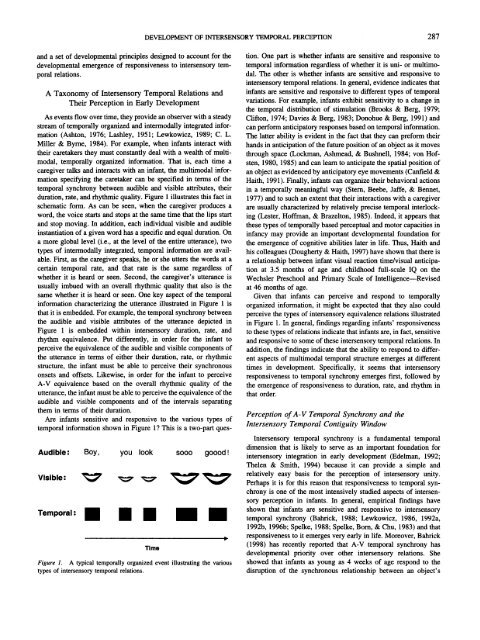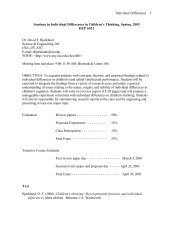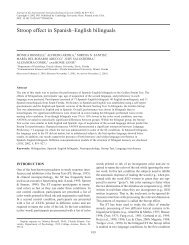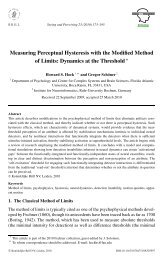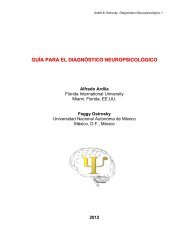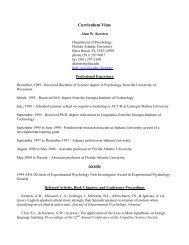286 LEWKOWICZties have either directly or indirectly explored the role <strong>of</strong> temporalinformation in intersensory integration. As a result, a substantialbody <strong>of</strong> research findings has become available on this question,and a relatively detailed and formal analysis <strong>of</strong> temporally basedintersensory perception in early development is now possible. It ishoped that such an analysis might permit the generation <strong>of</strong> somegeneral principles for the development <strong>of</strong> intersensory integrationand the specification <strong>of</strong> underlying processes with a degree <strong>of</strong>precision that has not been attempted to date.<strong>Perception</strong> <strong>of</strong> <strong>Temporal</strong> Information in <strong>Development</strong><strong>The</strong> temporal flow <strong>of</strong> events is an inescapable part <strong>of</strong> our life.By virtue <strong>of</strong> their temporal character, events can usually be characterizedin terms <strong>of</strong> duration, rate, and overall rhythmic quality. Inaddition, because most temporally organized objects and eventsare represented by multimodal sensory qualities, the sensory representations<strong>of</strong> these objects and events in each modality normallyoccur at the same time and, thus, are temporally contiguous. Agood example illustrating the intersensory temporal properties <strong>of</strong> amultimodal event is a person playing the violin. As the violinistdraws the bow across the strings, an observer can see and hear thatthe visible actions <strong>of</strong> the ann are temporally contiguous with theheard actions <strong>of</strong> the arm and that each discrete up-and-downmovement <strong>of</strong> the arm has a specific duration. In addition, as theviolinist repeatedly moves the bow up and down, the observer cansee and hear that the action occurs at a certain rate over time andthat it has a specific rhythmic quality to it.<strong>The</strong> fact that a human observer usually has little difficultyperceiving the equivalent nature <strong>of</strong> the visible and audible aspects<strong>of</strong> such an event is testimony to our general ability to integrate themultimodal properties <strong>of</strong> temporal events into unified perceptualexperiences. With specific regard to the integration <strong>of</strong> multimodaltemporal inputs, studies have shown that adults are sensitive to thetemporal synchrony <strong>of</strong> heteromodal inputs (Dixon & Spitz, 1980;Massaro, 1998; Massaro, Cohen, & Smeele, 1996; McGrath &Summerfield, 1985), respond to temporal variations in one modalitydifferently in the presence <strong>of</strong> temporal stimulation in anothermodality than in its absence (Myers, Cotton, & Hilp, 1981), andcan make intersensory matches based on the specific temporalpattern <strong>of</strong> stimulation (Gebhard & Mowbray, 1959; Handel &Buffardi, 1969). In contrast, infants find it more difficult, if notimpossible in some cases, to perceive the integral nature <strong>of</strong> certainforms <strong>of</strong> multimodal temporal structure (Lewkowicz, 1994a). Thisraises two questions. First, what abilities might infants lack andadults possess that make it possible to perceive the integral nature<strong>of</strong> multimodal, temporal structure? Second, how do such abilitiescome about in development?To be sure, such questions have been asked before, but theywere asked <strong>of</strong> children, not <strong>of</strong> infants, and were specificallyconcerned not with intersensory integration but with the generalquestion <strong>of</strong> the perception and understanding <strong>of</strong> time. Piaget(1969, 1970) carried out the classic investigations <strong>of</strong> these types <strong>of</strong>questions in children, and it was he who first pointed out thetheoretical importance <strong>of</strong> such questions for understanding thedevelopment <strong>of</strong> general perceptual and cognitive skills. Based onhis work on the perception <strong>of</strong> duration, Piaget proposed thatchildren initially cannot perceive time directly because they cannotcoordinate the distance that an object travels and the speed <strong>of</strong> itsmotion in estimating time. He based this conclusion on the resultsfrom his trains problem where children were shown two movingtrains and were asked to estimate the relative duration <strong>of</strong> travelwhen the trains' start and stop points, speed, and distance werevaried. He found that young children had difficulty coordinatingthe various indicators <strong>of</strong> duration and concluded that children mustconstruct the concept <strong>of</strong> time from information extracted aboutspeed and distance. In other words, he assumed that inferentialprocesses must operate on temporally discrete sense data and that,as a result, the perception <strong>of</strong> time and its duration is not directlyavailable to the perceptual system but must be inferred from otherknowledge. This theoretical position led Piaget to believe thatchildren do not attain a mature concept <strong>of</strong> time until middlechildhood, when they begin to understand the relationship betweentime, speed, and distance.In contrast to Piaget and his theory, E. J. Gibson (1969) positedthat duration is directly available to perception right from birth.Even more importantly, and in direct contrast to Piaget, Gibsonproposed that various temporal dimensions are amodal in natureand, as a result, that they are available to all sensory modalitiestight from birth. In fact, the results from subsequent studies investigatingchildren's perception <strong>of</strong> time are generally consistentwith this view in showing that children do not need to understandthe relationship between time, speed, and distance to have at leasta rudimentary understanding <strong>of</strong> time. <strong>The</strong>y show that as long aschildren understand the relative start and stop times <strong>of</strong> movingobjects, they are able to judge relative durations (Acredolo, 1989;Levin, 1982). What is not clear from these results, however, is howearly in development the ability to process multimodally represented,temporal information emerges. According to Gibson's theory,infants could be expected to perceive and integrate the multimodalattributes <strong>of</strong> temporal experience such as temporalsynchrony, duration, rate, and rhythm. Gibson takes it as a giventhat infants perceive intermodal invariants and thus, by extension,that they perceive the temporal relation between inputs in differentmodalities.At the time that Piaget and Gibson put forth their theoreticalpositions, there was little, if any, empirical information on infants'perception and responsiveness to multisensory temporal information.Since that time, however, a great deal <strong>of</strong> empirical evidencehas been gathered on this question, allowing it to be revisited. Ireview this empirical evidence and show that infants are capable <strong>of</strong>responding to intersensory temporal relations but that responsivenessto some types <strong>of</strong> temporal relations emerges earlier thanresponsiveness to others. Also, I show that, although Gibson'stheory predicts that infants should be able to pick up temporalintersensory relations right from birth and that they should becomemore adept at picking up increasingly more complex intersensoryrelations as they develop, the theory does not go far enough. Itdoes not specify when responsiveness to specific intersensorytemporal relations emerges, what processes underlie the emergence<strong>of</strong> responsiveness to increasingly more complex intersensorytemporal relations, and what processes are responsible for theobserved developmental transitions. <strong>The</strong> principal aim <strong>of</strong> the remainder<strong>of</strong> this article is to address these issues. This is done by (a)reviewing the empirical evidence on infants' responsiveness tointersensory temporal relations, (b) discussing extant theoreticalapproaches to the development <strong>of</strong> intersensory perception and tothe development <strong>of</strong> behavior in general, and (c) proposing a model
DEVELOPMENT OF INTERSENSORY TEMPORAL PERCEPTION 287and a set <strong>of</strong> developmental principles designed to account for thedevelopmental emergence <strong>of</strong> responsiveness to intersensory temporalrelations.A Taxonomy <strong>of</strong> <strong>Intersensory</strong> <strong>Temporal</strong> Relations and<strong>The</strong>ir <strong>Perception</strong> in Early <strong>Development</strong>As events flow over time, they provide an observer with a steadystream <strong>of</strong> temporally organized and intermodally integrated information(Ashton, 1976; Lashley, 1951; Lewkowicz, 1989; C. L.Miller & Byme, 1984). For example, when infants interact withtheir caretakers they must constantly deal with a wealth <strong>of</strong> multimodal,temporally organized information. That is, each time acaregiver talks and interacts with an infant, the multimodal informationspecifying the caretaker can be specified in terms <strong>of</strong> thetemporal synchrony between audible and visible attributes, theirduration, rate, and rhythmic quality. Figure 1 illustrates this fact inschematic form. As can be seen, when the caregiver produces aword, the voice starts and stops at the same time that the lips startand stop moving. In addition, each individual visible and audibleinstantiation <strong>of</strong> a given word has a specific and equal duration. Ona more global level (i.e., at the level <strong>of</strong> the entire utterance), twotypes <strong>of</strong> intermodally integrated, temporal information are available.First, as the caregiver speaks, he or she utters the words at acertain temporal rate, and that rate is the same regardless <strong>of</strong>whether it is heard or seen. Second, the caregiver's utterance isusually imbued with an overall rhythmic quality that also is thesame whether it is heard or seen. One key aspect <strong>of</strong> the temporalinformation characterizing the utterance illustrated in Figure 1 isthat it is embedded. For example, the temporal synchrony betweenthe audible and visible attributes <strong>of</strong> the utterance depicted inFigure 1 is embedded within intersensory duration, rate, andrhythm equivalence. Put differently, in order for the infant toperceive the equivalence <strong>of</strong> the audible and visible components <strong>of</strong>the utterance in terms <strong>of</strong> either their duration, rate, or rhythmicstructure, the infant must be able to perceive their synchronousonsets and <strong>of</strong>fsets. Likewise, in order for the infant to perceiveA-V equivalence based on the overall rhythmic quality <strong>of</strong> theutterance, the infant must be able to perceive the equivalence <strong>of</strong> theaudible and visible components and <strong>of</strong> the intervals separatingthem in terms <strong>of</strong> their duration.Are infants sensitive and responsive to the various types <strong>of</strong>temporal information shown in Figure 1 ? This is a two-part ques-Audible: Boy, you look sooo goood !Visible: ~ ~ ~, ~ '<strong>Temporal</strong> :TimeFigure 1. A typical temporally organized event illustrating the varioustypes <strong>of</strong> intersensory temporal relations.Ption. One part is whether infants are sensitive and responsive totemporal information regardless <strong>of</strong> whether it is uni- or multimodal.<strong>The</strong> other is whether infants are sensitive and responsive tointersensory temporal relations. In general, evidence indicates thatinfants are sensitive and responsive to different types <strong>of</strong> temporalvariations. For example, infants exhibit sensitivity to a change inthe temporal distribution <strong>of</strong> stimulation (Brooks & Berg, 1979;Clifton, 1974; Davies & Berg, 1983; Donohue & Berg, 1991) andcan perform anticipatory responses based on temporal information.<strong>The</strong> latter ability is evident in the fact that they can preform theirhands in anticipation <strong>of</strong> the future position <strong>of</strong> an object as it movesthrough space (Lockman, Ashmead, & Bushnell, 1984; von H<strong>of</strong>sten,1980, 1985) and can learn to anticipate the spatial position <strong>of</strong>an object as evidenced by anticipatory eye movements (Canfield &Halth, 1991). Finally, infants can organize their behavioral actionsin a temporally meaningful way (Stem, Beebe, Jaffe, & Bennet,1977) and to such an extent that their interactions with a caregiverare usually characterized by relatively precise temporal interlocking(Lester, H<strong>of</strong>fman, & Brazelton, 1985). Indeed, it appears thatthese types <strong>of</strong> temporally based perceptual and motor capacities ininfancy may provide an important developmental foundation forthe emergence <strong>of</strong> cognitive abilities later in life. Thus, Haith andhis colleagues (Dougherty & Haith, 1997) have shown that there isa relationship between infant visual reaction time/visual anticipationat 3.5 months <strong>of</strong> age and childhood full-scale IQ on theWechsler Preschool and Primary Scale <strong>of</strong> Intelligence---Revisedat 46 months <strong>of</strong> age.Given that infants can perceive and respond to temporallyorganized information, it might be expected that they also couldperceive the types <strong>of</strong> intersensory equivalence relations illustratedin Figure 1. In general, findings regarding infants' responsivenessto these types <strong>of</strong> relations indicate that infants are, in fact, sensitiveand responsive to some <strong>of</strong> these intersensory temporal relations. Inaddition, the findings indicate that the ability to respond to differentaspects <strong>of</strong> multimodal temporal structure emerges at differenttimes in development. Specifically, it seems that intersensoryresponsiveness to temporal synchrony emerges first, followed bythe emergence <strong>of</strong> responsiveness to duration, rate, and rhythm inthat order.<strong>Perception</strong> <strong>of</strong> A-V <strong>Temporal</strong> Synchrony and the<strong>Intersensory</strong> <strong>Temporal</strong> Contiguity Window<strong>Intersensory</strong> temporal synchrony is a fundamental temporaldimension that is likely to serve as an important foundation forintersensory integration in early development (Edelman, 1992;<strong>The</strong>len & Smith, 1994) because it can provide a simple andrelatively easy basis for the perception <strong>of</strong> intersensory unity.Perhaps it is for this reason that responsiveness to temporal synchronyis one <strong>of</strong> the most intensively studied aspects <strong>of</strong> intersensoryperception in infants. In general, empirical findings haveshown that infants are sensitive and responsive to intersensorytemporal synchrony (Bahrick, 1988; Lewkowicz, 1986, 1992a,1992b, 1996b; Speike, 1988; Speike, Born, & Chu, 1983) and thatresponsiveness to it emerges very early in life. Moreover, Bahrick(1998) has recently reported that A-V temporal synchrony hasdevelopmental priority over other intersensory relations. Sheshowed that infants as young as 4 weeks <strong>of</strong> age respond to thedisruption <strong>of</strong> the synchronous relationship between an object's


